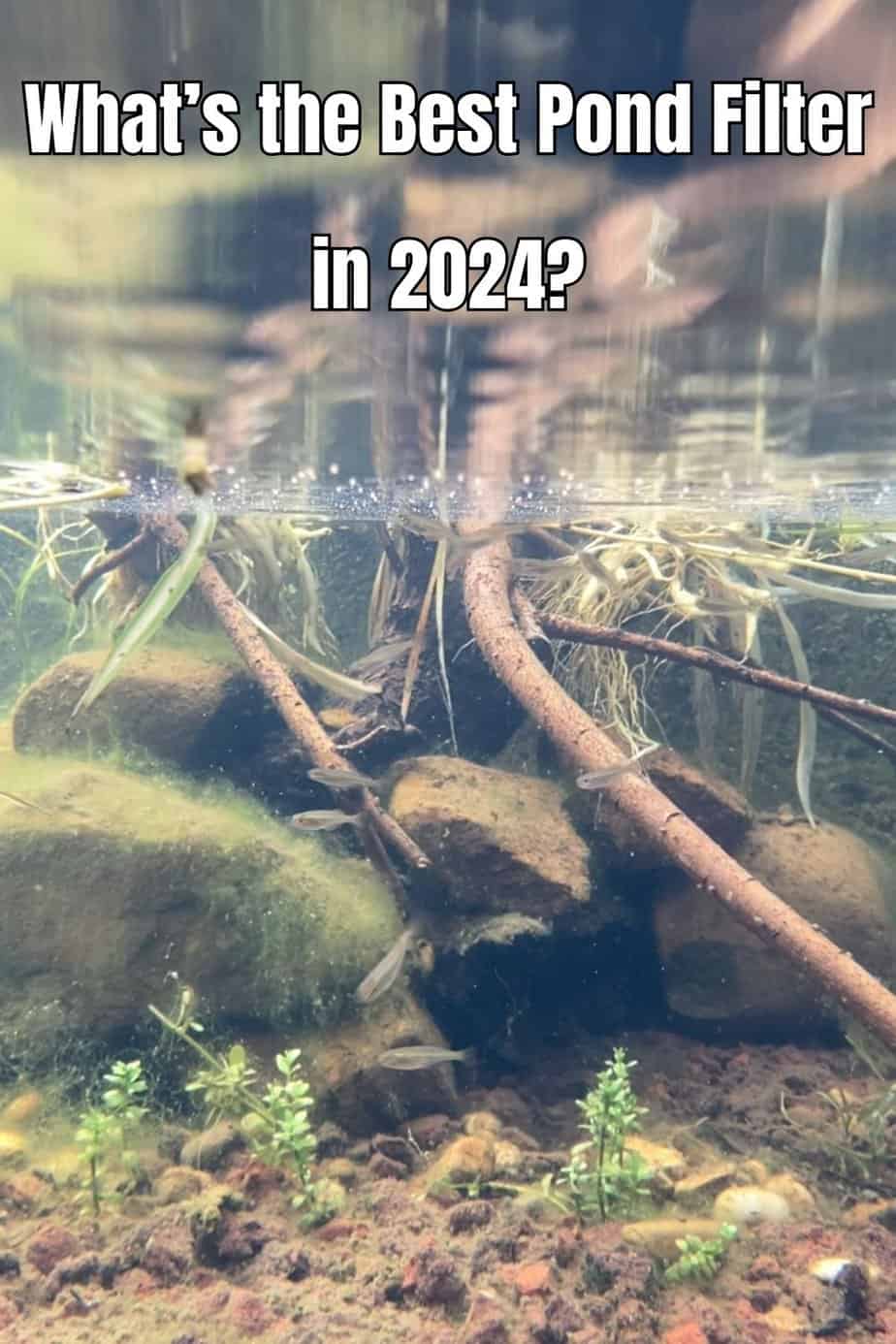The type of filter you need depends on what type of pond you have. Some ponds need more filtration and some won’t even need any at all.
First let’s look at what type of pond you have or would like. Then we can discuss the options.
You can easily build your own pond filter or you can buy one ready to just plug and play. Throughout this article I will show videos to some of my various ponds so you can see how they are filtered.
Here is a list of five different types of pond. Select which one best represents your pond situation and then select a filter that resonates with you.
| Pond or Water feature type | Filter options |
| Fish pond | -Canister or pressure filter -Waterfall filter and skimmer -Filter and pump all in one unit -Bog or wetland filter -Homemade filters -No filter |
| Koi pond | -Waterfall filter and skimmer -Shower filters -Bog or wetland filter -Bottom drains -Moving bed filters |
| Water garden or wildlife pond | – No filter -Filter and pump all in one unit |
| Pondless stream or water fountain | – No filter -Copper ion additive -UV- light |
| Recreation/ swim pond | – Bog or wetland filter – Re-generation zones |
You might also find it useful to work out how many fish you can have in your pond.
Filter options for a fish pond
A fish pond needs a filter because fish produce ammonia. Ammonia is toxic to fish. Bacteria is needed to process ammonia into nitrite and finally nitrate.
This is a process called the nitrogen cycle. Below is one of my videos explaining how biological filtration works.
The bacteria that form the backbone of the nitrogen cycle are the most important filter for a pond with fish.
Because living bacteria are the main filtering component this filter is called a biological filter. All fish ponds must have a well functioning biological filter for the safety of the fish.
The bacteria live on all wet surfaces in the pond. This means that all ponds already have some kind of biological filter.
But unless you only want to keep a couple of fish you will need to add a pump that circulates water through a well designed filter. If you only want a few fish it can be possible to create a filter free pond.
If you want quite a few fish, there are many types of filters that will work for ponds with fish, let’s take a look.
Bog or wetland filters
These are my favourite filter hands down!
Bog filters mimic what already occurs in nature. They can be made yourself and provide the best results.
They can be used on tiny ponds like this wine barrel pond.
Right up to the largest of ponds like my dream pond. A bog filter can sit inside the pond or be seperate and connected via a stream or waterfall. Below is a quick overview video on how I built my dream pond.
To provide superior filtration a bog filter is substantially bigger than all the other filters I’ve mentioned. A good starting point for a bog filter size is 10% of the ponds surface area (for a fish pond).
If you want more information i have an article titled “how to size a bog filter“.
Biological filtration is provided using rocks and gravel. Water is pumped into the bottom of the bog and percolates up through the rocks and gravel.
Moving the water up slowly is important. This gives the nitrifying bacterias more time to purify and polish the water.
I feel like this is something that all other filters fail to achieve. I also have an article talking about bog filter flow rates if you would like to learn more.
Plants can be placed directly into the gravel. This can create a beautiful looking water garden, but it serves so many practical purposes.
Remember the nitrogen cycle?
Ammonia- Nitrite – Nitrate.
Plants consume nitrate, so by placing them right there directly in the filter itself… They grow like crazy!
This means that there is a very minimal supply of nutrients in the pond and that means less to no algae. Below is a video I made taking about how plants help filter the water.
The roots of the plants will also trap sediment. Basically filling the role of sponges in the more conventional filters.
When designing a bog or wetland filter it is important to provide an area below the gravel and rocks where muck and sediments can accumulate. This is so you can easily pump or flush the filter without removing all the rock and gravel.
Below is a video showing how I clean a DIY bog filter.
Advantages of a bog filter
- Best results
- Completely natural
- Scalable- can be used on tiny ponds right up to massive ponds
- DIY friendly
- Looks great
- Incredibly low maintenance
- Very cost effective
Disadvantages of a bog filter
- Requires a bit of homework to design a good one (my tip start with a small project then scale up)
If you are interested in creating a DIY bog filter or you like the way I construct my ponds, you might like to download the formulas I use to build my ponds PDF.
Waterfall and skimmer filters
This type of setup is my personal favourite, if you are going to buy a filter system.
One because it works really well, two it’s very easy to install and three, because it allows you to create a really natural looking pond.
Aquascape is the market leader in this area, although there are many more manufactures entering the space of waterfall filters and skimming units.

The waterfall filter (Amazon link) provides the main biological filter. It houses bio balls. Being a much larger unit than a canister filter it provides much greater room for more beneficial bacteria.
More nitrifying bacteria leads to better water quality but also the ability to keep more fish.
The waterfall filter also has a filter sponge to help trap fine sediments. Again much larger than those in the canister filter.
This means you can go much longer between cleaning. It is possible to DIY your own waterfall filter. Below is a video showing how I did just that.
The other component of this one, two combo is the skimmer (Amazon link). The skimmer is mostly a mechanical filter.
It works by creating tension on the waters surface. The pump sits inside the skimmer pulling the water in. This allows floating debris such as leaves and dust to be pulled into the skimmer.
Here it can easily be scooped out and removed. The skimmer will also have a sponge to trap sediments.
The skimmer, waterfall filter combo makes pond ownership very easy with minimal maintenance ever required.
I have made my own skimmers and they are very effective and on a large pond the use of an intake bay is a great DIY solution to pond skimming.
A Skimmer/ waterfall filter combo are much more expensive than pressure/ canister filters. I think they are only worth the investment on ponds that are 2000 litres (500gal) or more.
If you are interested I created a pond using a DIY skimmer in a bucket and a DIY bog filter to save money. The pond also has a small waterfall and a stream.
Advantages of waterfall and skimmer filters
- Provide much more biological and mechanical filtration than a canister filter.
- Keep more fish.
- Very easy to maintain.
- Easy to incorporate into the landscape.
Disadvantages of waterfall and skimmer filters
- Can be quite expensive.
- A little tricky to retrofit to an existing pond if you haven’t done it before.
Canister or pressure filter
These filters work by pumping water from the pond into the filter.
The water is pushed through a series of sponges and media that provide surface are for the nitrifying bacteria.
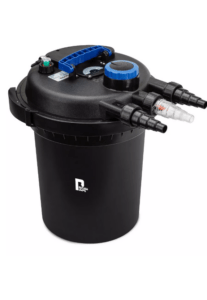
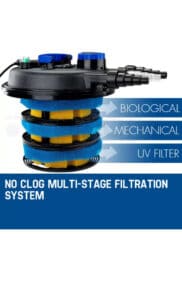
The sponges also provide surface are for the bacteria but their main function is to trap small sediments.
This is another type of filtration called mechanical filtration.
The media within the filter is normally bio balls or ceramic noodles. They are there because they provides lots of surface area for the bacteria in a small area.
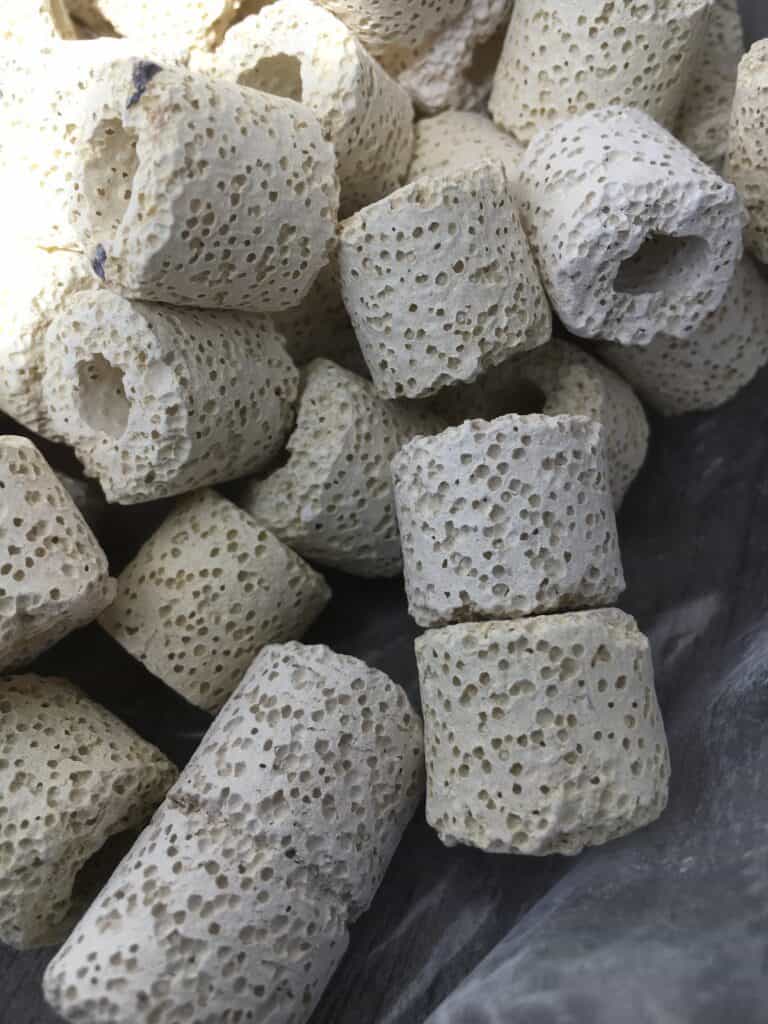
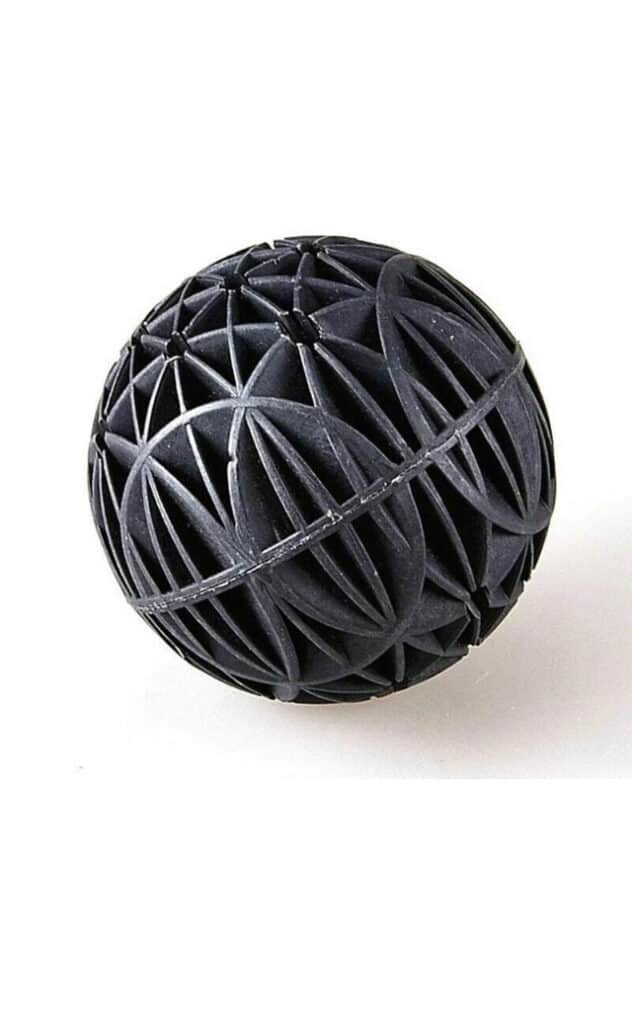
So as the water is pushed through the filter the bacteria can process the ammonia and the nitrite into nitrate. Keeping the water fish safe.
By trapping small sediments the sponges help keep the water clear.
Most of these filters also include a UV light built in. The UV light kills single celled algae.
This is the type of algae that will turn a pond green and make it hard to see the fish.
For me canister or pressure filters are best suited for ponds under 1000 litres (254 gal). Click here to check out canister filter options on Amazon.
Advantages of canister and pressure filters
- They are pretty cheap
- Nice and small
- Easy to add to an existing pond
Disadvantages of canister and pressure filters
- Only suitable for small ponds with low fish numbers (in my opinion)
- Require more maintenance than most people realise
- Pipes need to leave the pond. This opens up the potential for leaks.
All in one filter pump combo
The all in one filter and pump option is only really suited to small ponds in my opinion.
It works just like the canister or pressure filter just everything in submerged and housed in a unit that includes the pump.
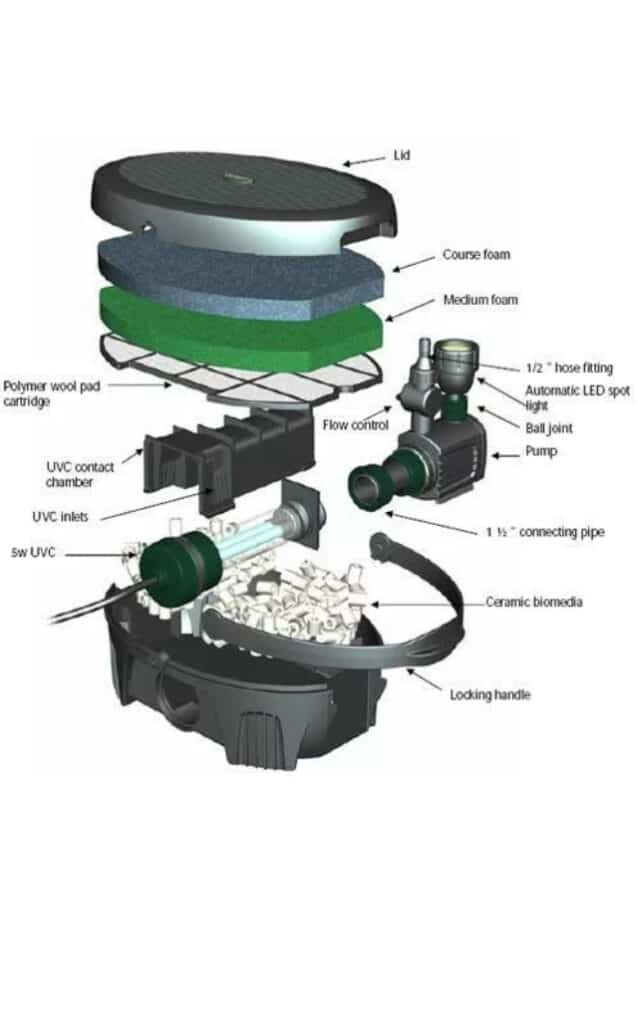
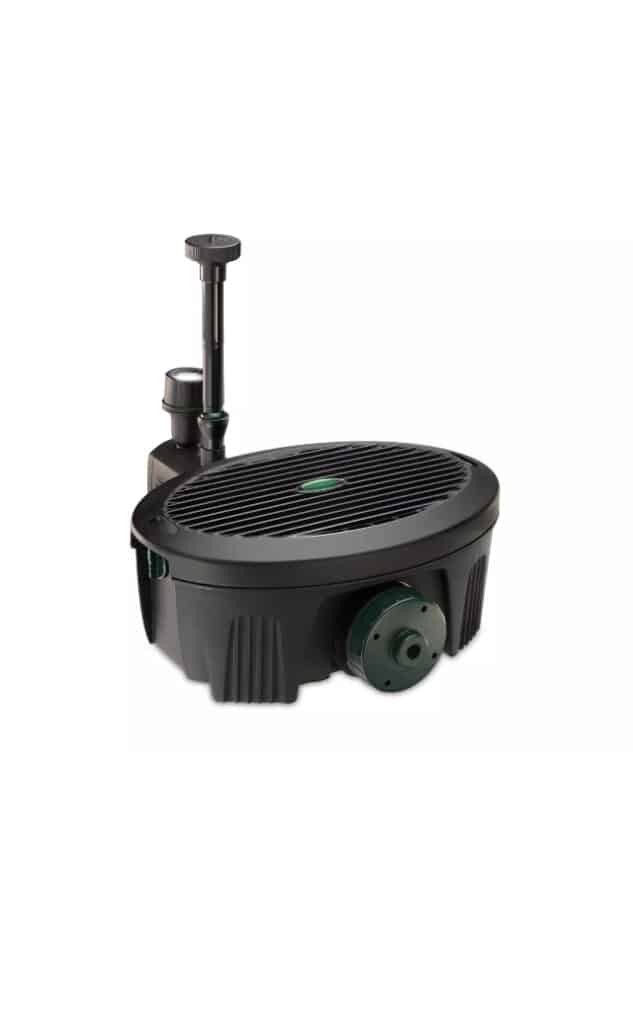
Like all the other filters it has sponges to trap sediment and filter media to grow nitrifying bacteria. Most will also include a UV light to prevent single-celled algae.
Again it’s pretty easy to make your own All-in-one filter. I take a plant pot and block the drainage holes with a coarse sponge, I place the pump inside the pot, you can add filter media and cover the top of the pot with another coarse sponge.
Here’s a video showing how I do that to keep my small fish safe in my smaller ponds. In this video I also built a bog filter so I didn’t need to surround the pump with filter media.
Advantages of all in one pond filters
- Very easy to install
- Pretty cheap when you consider the pump is included
Disadvantages of all in one pond filters
- Only suitable for small ponds and light fish numbers
- Clog easy
- Frequent maintenance
- Entire unit is submerged and needs to be removed to clean
Filter options for a koi pond
Koi fish are much larger than most other fish kept in ponds and therefore require supercharged filter systems.
Some koi are also awfully expensive. Some people want to just display the koi, while others want to incorporate koi into a more natural looking pond.
For those wanting to go the more natural looking pond I would stick with either a waterfall and skimmer filter combo or a skimmer/ Intake bay and bog filter combo.
For those looking to create a pond built solely to showcase their beautiful koi. You’ll be looking at something a bit more specialised and a bit more expensive.
Bottom drain for koi ponds
So the majority of serious koi people have a bottom drain. This is a mechanical filter.
Its main purpose is to remove the fish waste, uneaten food or other debris that settles in the bottom of the pond.
A skimmer can still be incorporated if desired.
Some people will use a solids handling submersible pump rather than installing a bottom drain.
The function is the same though solid waste is removed from the bottom of the pond and transferred to the main filter.
Advantages of bottom drains
- Very effective at removing waste from the bottom of the pond
Disadvantages of bottom drains
- Costly to set up.
- Can be a problem to fix if you get a blockage
Shower filter for koi ponds
Shower filters work in a similar way to all the other biological filters.
But rather than forcing the water through the media that grows the bacteria, it is pumped up and showered down through the media and sponges.
This allows for a good exchange of oxygen which is great for the nitrifying bacteria this allows them to function incredibly efficiently.
They are expensive to buy but possible to build yourself.
Advantages of shower filters
- Very effective at removing solids
- Great oxygen exchange which super charges nitrifying bacteria
- Can be DIY
Disadvantages of shower filter
- Very expensive if purchased
- Large units, difficult to hide
- Plenty of maintenance
Moving bed filter for koi ponds
Moving bed filters usually comprise of 3 or more barrels or drums that contain different media to seperate solids and grow beneficial bacteria.
The water is usually pumped into the first barrel where the water is swirled around. This creates a sort of vortex.
The idea is that the heavy soil waste will fall out of the water column and settle in the bottom of the barrel.
Then the water moves onto the second barrel where different grades of sponges are waiting.
This separates the smaller particles that made it through the first barrel.
Lastly is the barrel containing all the filter media that is used to grow the bacteria.
Most often this is something like a K1 filter media.

At he bottom of this barrel is an air-stone. This keeps the media constantly in motion. Hence the name moving bed filter.
The oxygen rich environment supercharges the nitrifying bacteria in as was the case with a shower filter.
Advantages of a moving media bed filter
- Great amounts of oxygen for the bacteria
- Can be a DIY project
- Only really the sponges that need a cleaning once in a while
Disadvantages of moving media bed filter
- Takes up a lot of room
- Lots of pipework
- Difficult to hide
Filter options for a wildlife pond or water garden
In a wildlife pond or water garden you shouldn’t need a filter. The Pond or water garden should be able to find a nice sustainable balance.
For one there is no fish. So not so much ammonia is being produced. Some will still occur when organic materials in the pond break down.
In your wildlife pond or water garden its a good idea to incorporate rocks and gravel. Below is a video showing how I constructed a filterless pond in a wine barrel. This pond also has a few fish.
It looks nice but more importantly will give you that much needed surface area for beneficial bacteria.
Then of course you will also include plenty of plants 50-75% of the pond will have aquatic vegetation.
This is going to consume plenty of nutrients and prevent algae being a problem.
If you want to add a filter at the beginning an all in one filter will be fine. Another option are these cool filter urns as shown in Mark Wilson’s video below.
Water treatments for Water fountains and pond-less streams
Again in a pondless stream or water fountain set up you shouldn’t need a proper filter.
However you may find that you get problems with string or hair algae. This is completely natural but can look very unsightly.
There are a couple of things you can do.
First you could add chlorine, but this is not very environmentally friendly for local birds that might want to come down for a drink and a wash.
Second you could add an algaecide (Amazon link). You can buy ones that are perfectly safe for birds, plants and fish, however they will kill invertebrates like shrimp and snails. Filling the stream with a diverse range of marginal plants is a better option in my opinion.
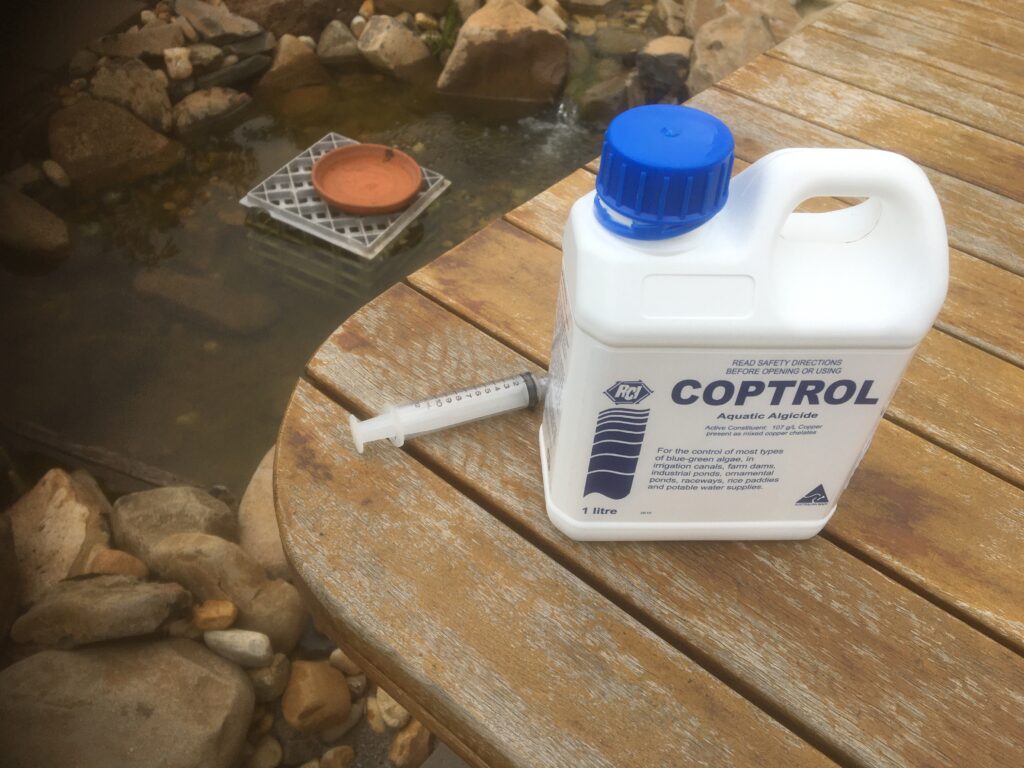
Aquascape also have 2 products that may be quite useful.
One is called an ion-get (Amazon link). This is a small copper rod of sorts that releases small amounts of copper ions into the water.
My understanding is this works similar to an algaecide as the copper destroys the cell structure of the algae. Again, it is no good for invertebrates.
If you have green water a UV clarifier (Amazon link) will fix that. They work by exposing the algae to intense ultraviolet light. It breaks the cell apart and kills the algae.
Filter option for swim or recreation ponds
Because people are swimming in it the water quality needs to be pristine! To achieve this we look to nature and replicate the wetland or bog systems.
There are two ways this is commonly achieved.
One is the use of a wetland or bog filter. The other is a re-generation zone.
Both are using plants and nitrifying bacteria to create that pristine water quality.
Wetland or Bog filter for a swim pond
Some interesting facts about wetlands and bogs:
- 1 acre of healthy wetland is able to purify 27,633,506 Litres of polluted dirty water!
- A healthy wetland can remove 96% of all nitrogen in the water!
- A healthy wetland can remove 97% of the phosphorus within the water.
Pretty impressive!
If you go the bog or wetland route you want to size it at approximately 25% of the surface area of the pond.
Here is an incredible pond created by Patrick Handley of Waterscapes Australia.
If this is something that interests you there are kits available from rock around the block. Use the code “OZPONDS” for a discount. (Only Available to Australian Customers).
Regeneration filter for a swim or recreation pond
The other option is the regeneration zone. These are very popular in Europe but are slowly spreading worldwide.
I find these quite intriguing as they are powered by an air pump rather than a submersible or external pump.
This is fantastic for a few reasons:
- No risk of being electrocuted by the bubbles.
- An airline can be ran for a hundred metres if you needed to. This means no need to run electricity all the way to the pond.
- Incredibly energy efficient. The video below shows a pond David Pagan Bulter is running with a solar powered air pump.
In these pools the regeneration zone is the same size as the swim zone.
You can purchase a complete guide on how these pool are constructed from Davids Website.
Conclusion
So as you can see there are many different types of filters but they all work in very similar ways.
For me a Bog filter is the way to go in almost all situations. Like I mentioned they can be adapted for tiny ponds up to the largest of recreation ponds.
They are completely natural and great for local bio diversity.
I hope you have found this article helpful and you feel confident in selecting the right filter for your pond or other water feature.
If you would like to sign up to my mailing list where i share tips and special discounts please click the button below.
Thanks for reading!

